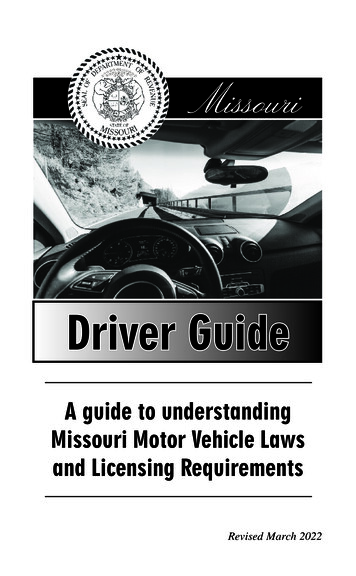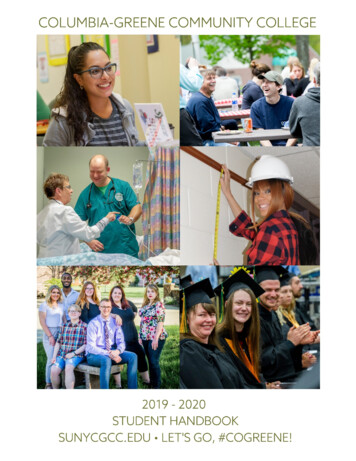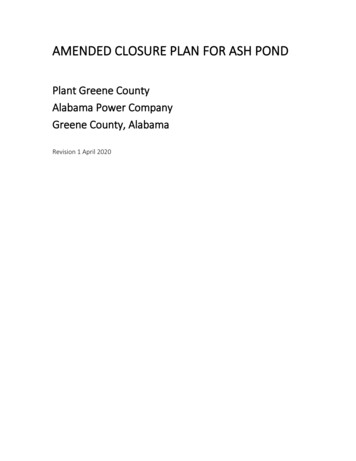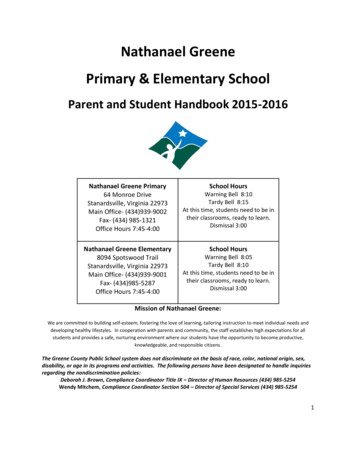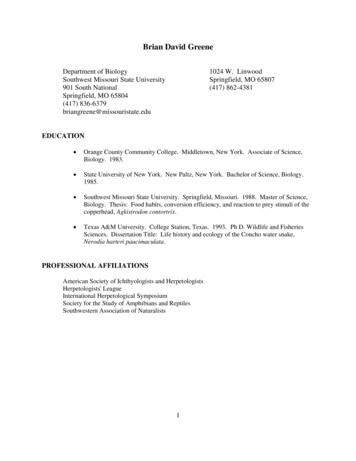
Transcription
Brian David GreeneDepartment of BiologySouthwest Missouri State University901 South NationalSpringfield, MO 65804(417) 836-6379briangreene@missouristate.edu1024 W. LinwoodSpringfield, MO 65807(417) 862-4381EDUCATION Orange County Community College. Middletown, New York. Associate of Science,Biology. 1983. State University of New York. New Paltz, New York. Bachelor of Science, Biology.1985. Southwest Missouri State University. Springfield, Missouri. 1988. Master of Science,Biology. Thesis: Food habits, conversion efficiency, and reaction to prey stimuli of thecopperhead, Agkistrodon contortrix. Texas A&M University. College Station, Texas. 1993. Ph D. Wildlife and FisheriesSciences. Dissertation Title: Life history and ecology of the Concho water snake,Nerodia harteri paucimaculata.PROFESSIONAL AFFILIATIONSAmerican Society of Ichthyologists and HerpetologistsHerpetologists' LeagueInternational Herpetological SymposiumSociety for the Study of Amphibians and ReptilesSouthwestern Association of Naturalists1
TEACHING EXPERIENCEBiology Lecture/Lab Courses—SMSU/MSU:General Biology II (BIO 122). The second in a two semester series of four credit introductorycourses required for biology majors. This course covers biodiversity, phylogeny, structure andfunction of major taxa, and ecology.Principles of Biological Science (BIO 102). A comprehensive general biology course for nonmajors.General Ecology (BIO 369). A standard 300-level undergraduate ecology course (lecture andlab) for biology majors.Principles of Ecology (BIO 269). A sophomore-level non-majors ecology course designed forstudents seeking an environmental studies minor. Content included a comprehensive introductionto ecology with an applied environmental emphasis presented in a lecture-discussion format.Biometry (BIO 550). A 500-level introductory course on the concepts, methods, and applicationof statistics in the biological sciences. Enrollment restricted to upper division undergraduates andgraduate students.Biometry Laboratory (BIO 551). A computer-based course stressing the analysis of biologicaldata using statistical software.Herpetology (BIO 576). A senior/graduate level course emphasizing the evolutionary history ofamphibians and reptiles focusing on the adaptations that explain how they function in biologicalsystems. The laboratory component emphasized identification of local taxa.Comparative Vertebrate Anatomy Laboratory (BIO 380). Lab component of a 300-levelcourse on the evolutionary history of the vertebrates. Muscular, nervous, digestive, andurogenital systems were compared among mammals, fishes, agnathans, and amphibians. Allvertebrate classes were represented in the study of the skeleton.Field Zoology (BIO 374). A course emphasizing the taxonomy and natural history of thevertebrates. The lab component includes field trips to sample local fauna.Population Ecology (BIO 563). A graduate-level course on the theory and practice of ecologicalaspects of population biology. Co-taught with John Havel.Conservation Biology (BIO 579). A graduate-level course on the theory and practice ofconserving biodiversity. Co-taught with Alexander Wait.2
Specialty Courses:Introduction to University Life (IDS 110). Course for new freshmen designed to facilitateassimilation into the university environment.Desert Ecology (BIO 527). A two-week field course investigating the ecological characteristicsof the four desert regions in the southwestern United States. Students conducted projectscomparing organisms among the four desert regions. summer 1997.Graduate seminar (BIO 628). Topic-oriented courses emphasizing discussion and criticalevaluation of primary literature. I have been involved with two separate topics: (1) Predator-PreyEcology of Amphibians and Reptiles, and (2) Life history phenomena in vertebrates.PROFESSIONAL EXPERIENCEFall 2000 - Assistant Professor, Department of Biology, Southwest Missouri State/Missouri StateUniversity.Fall 1995 - summer 2000. Lecturer, Department of Biology, Southwest Missouri StateUniversity, Springfield, Missouri.Fall 1993 - Spring 1995. Adjunct faculty, Drury College, Springfield, Missouri.PROFESSIONAL ACTIVITIESReviewer ServiceJournals: African Journal of Herpetology, American Midland Naturalist, Copeia, HerpetologicalNatural History, Herpetological Review, Journal of Herpetology, Southeastern Naturalist,Southwestern Naturalist, Texas journal of Science, Herpetologica, Ecological Applications,WetlandsEdited Volumes: Biology of the Rattlesnakes, chapter on relationships between insolation andrattlesnake hibernaculaText Books and Professional References: Audesirk, T. and G. Audesirk. 1996. Life on Earth. Prentice-Hall Inc., Simon andSchuster, Upper Saddle River, New Jersey. A general biology text intended for nonmajorsMiller and Levine. Non-major’s general biology text. Review of evolution chapters for1st ed. WH Freeman.Pough et al. 2nd ed. Herpetology. Prentice Hall.3
Grant Proposals: National Fish and Wildlife Foundation - Bottomland Forest Cane Stand andHardwood Restoration in the Lower Ozarks. Submitted by Missouri Dept. ofConservationMiscellaneous Materials: Texas Parks and Wildlife Department endangered species education materials 1994.Book Chapter on marking techniques for reptiles. January 2001Paper session moderation Reptile ecology. Annual meeting of the Southwestern Association of Naturalists. SouthwestMissouri State University, Springfield, Missouri. 1993.General herpetology. Annual meeting of the Southwestern Association of Naturalists. CentenaryCollege, Shreveport, Louisiana. 1995.Reptiles and invertebrates. Annual meeting of the Southwestern Association of Naturalists. SanAntonio, Texas. 2004.Miscellaneous Associate Editor for Herpetology: American Midland Naturalist, August 1997-January 2004.Concho water snake recovery team. U.S. Fish and Wildlife Service. 1991-1994.Consultant to U.S. Fish and Wildlife Service, Concho water snake population viability. August2000-present.AWARDSPersonal Excellence in Teaching, College of Natural and Applied Sciences, 8 November 2001.Excellence in Service, College of Natural and Applied Sciences, 22 October 2002Awards to mentored students April Brennan – Boritski Scholarship, 2003William Ray – Best oral presentation, SMSU Graduate Interdisciplinary Forum, 2004Adam Crane - Best oral presentation and nominee for best teaching assistant, SMSU GraduateInterdisciplinary Forum, 20054
INVITED PRESENTATIONS The use of bar-coding in snakes. Texas A&M University, Department of EngineeringTechnology. March 1989.Ecology and conservation of the Concho water snake. Department of Biology, The University ofTexas at Tyler. April 1992.Ecology of the Concho water snake: conservation implications for an endangered species.Seminar, Department of Biology, Southwest Missouri State University. October, 1993.Ecology of the Concho water snake: implications for conservation and management. Seminar,Illinois Natural History Survey, The University of Illinois, April 1999.Conservation Biology of Harter’s Water Snake. Seminar, Department of Zoology, OklahomaState University, December 1999.Conservation Biology of Harter’s Water Snake. Seminar, Department of Biology, University ofArkansas, March 2000.Conservation Biology of Harter’s Water Snake. Seminar, Department of Biology, University ofMississippi, September 2003.Sources of spatial pattern variation of a stream-associated cottonmouth population, WashingtonUniversity (St. Louis), May 2006.ORAL PRESENTATIONSProfessional MeetingsGreene, B.D. Food habits of the copperhead, Agkistrodon contortrix, in Southwest Missouri.Colloquium on Biology in the Mid-South, Memphis State University. Memphis, Tennessee.March 1988.Greene, B.D. Studies on conversion efficiency of the copperhead, Agkistrodon contortrix.Annual meeting of the Southwestern Association of Naturalists. Angelo State University, SanAngelo, Texas. April 1988.Greene, B.D., and J.R. Dixon. Food habits of the Concho water snake (Nerodia harteripaucimaculata). Annual meeting of the Southwestern Association of Naturalists. Arkansas StateUniversity, Jonesboro, Arkansas. April 1989.Greene, B.D., and J.R. Dixon. Reproduction and maturity in the Concho water snake, Nerodiaharteri paucimaculata. Annual joint meeting of the Herpetologists' League and the Society forthe Study of Amphibians and Reptiles. Tulane University, New Orleans, Louisiana. August1990.Greene, B.D., and J.R. Dixon. Habitat use and adult home range size of adult Concho watersnakes, Nerodia harteri paucimaculata. Annual meeting of the Southwestern Association ofNaturalists. The University of Texas at El Paso, El Paso, Texas. April 1991.Greene, B.D., and J.R. Dixon. Feeding Ecology of the Concho water snake, Nerodia harteripaucimaculata. Annual joint meeting of the Herpetologists' League and the Society for theStudy of Amphibians and Reptiles. Penn State University, State College, Pennsylvania. August1991.Greene, B.D., and J.R. Dixon. Growth and reproduction of the Concho water snake. Annualmeeting of the Texas Herpetological Society. Trinity University, San Antonio, Texas.November 1991.5
Greene, B.D., and J.R. Dixon. Conservation of the Concho water snake. Annual meeting of theTexas Academy of Science. Midwestern University, Wichita Falls, Texas. March 1992.Greene, B.D., and J.R. Dixon. Growth and sexual dimorphism in the Concho water snake,Nerodia harteri paucimaculata. Annual meeting of the Southwestern Association ofNaturalists. Texas Tech University field station, Junction, Texas. April 1992.Greene, B.D. Growth and sexual dimorphism in the Concho water snake, Nerodia harteripaucimaculata. Joint meeting of the American Society of Ichthyologists and Herpetologists andthe Herpetologists' League. The University of Illinois, Champaign-Urbana, Illinois. June 1992.Greene, B.D. Conservation and management of the Concho water snake (Nerodia harteripaucimaculata). Conservation symposium at annual meeting of the Society for the Study ofAmphibians and Reptiles. The University of Texas at El Paso, El Paso, Texas. August 1992.Greene, B.D. and J.R. Dixon. Seasonal activity patterns of an aquatic snake community incentral Texas. Annual meeting of the Southwestern Association of Naturalists. SouthwestMissouri State University, Springfield, Missouri. April 1993.Greene, B.D. Habitat use and spatial ecology of the Concho water snake, Nerodia harteripaucimaculata. Joint meeting of the American Society of Ichthyologists and the Herpetologists'League. The University of Texas, Austin, Texas. May 1993.Greene, B.D. Feeding ecology of an aquatic snake guild in central Texas. Annual meeting of theSouthwestern Association of Naturalists. Centenary College, Shreveport, Louisiana. April 1995.Fobes, T.M., R.F. Wilkinson, and B.D. Greene. Habitat utilization of the Ozark hellbender inMissouri. Annual meeting of the Southwestern Association of Naturalists. Centenary College,Shreveport, Louisiana. April 1995.Greene, B.D. Growth patterns in the Concho water snake, Nerodia harteri paucimaculata.Annual meeting of the Society for the Study of Amphibians and Reptiles. Boone, North Carolina.August 1995.Greene, J.S. and B.D. Greene. The use of reptiles and amphibians in the classroom. Annualmeeting of the National Association of Biology Teachers. Phoenix, Arizona. October 1995.Greene, B.D. and S. Mathis. Responses of the blunt-headed tree snake, Imantodes cenchoa, tochemical cues from potential prey. Annual meeting of the Southwestern Association ofNaturalists. University of Arkansas. April 1997.Greene, B.D., M.J. Whiting, and J.M. Mueller. Demography and life history of Nerodiaharteri paucimaculata. Joint meeting of the American Society of Ichthyologists andHerpetologists, the Herpetologists' League, and the Society for the Study of Amphibians andReptiles. University of Washington. June 1997.Boeckman, D, M Clark, R. Powell, B. Greene, and J. Lynch. Eleutherodactylus loki(Leptodactylidae): Natural history and polymorphism, with notes on the leaf litter frogcommunity of the Los Tuxtlas region, Veracruz, Mexico. Annual meeting of the MissouriHerpetological Association. Jefferson City, Missouri. September 1997.Roth, T.C. and B.D. Greene. Spatial ecology of the northern water snake (Nerodia sipedon) in asouthwest Missouri lake. Joint meeting of the AmericanSociety of Ichthyologists andHerpetologists, the Herpetologists’ League, and the Society for the Study of Amphibians andReptiles. Penn State University. June 1999.Greene, B.D. and T. C. Roth III. Habitat use of Nerodia sipedon in a southwest Missouri lake.Annual meeting of the Missouri Herpetological Association. Lay Field Station, Louisiana,Missouri. September 1999.Greene, B.D. Spatial ecology and habitat use of Nerodia sipedon in a southwest Missouri lake.Fall meeting of the Texas Herpetological Society; symposium in honor of James R. Dixon, TexasA&M university, October 1999.Greene, B.D. Ecology of the western cottonmouth in southwest Missouri. Annual meeting of6
the Missouri Herpetological Association. Reis Field Station, September 2001.Greene, B.D. Ecology of the western cottonmouth in southwest Missouri. Annual meeting ofthe Southwestern Association of Naturalists. Norman, OK, 18 April 2003.McCloud, K.D. and B.D. Greene. Avoidance of Predator chemical cues by northern watersnakes. Annual Meeting of the Southwestern Association of Naturalists. Norman, OK, 18 April2003.Lehnhoff, L. and B.D. Greene. Spatial ecology and habitat use of Blanding’s turtle at SquawCreek National Wildlife Refuge. Annual Meeting of the Southwestern Association of Naturalists.Norman, OK, 18 April 2003Ray W. and B.D. Greene. Effect of prey type on foraging behavior of the cottonmouth,Agkistrodon piscivorus. Annual meeting of the Southwestern Association of Naturalists.Norman, OK, 18 April 2003.Lehnhoff, L., B.D. Greene, and F.L. Durbian. Spatial ecology of Blanding’s Turtle at SquawCreek National Wildlife Refuge. Annual meeting of the Missouri Herpetological Association,Reis Biological Station, September 2003.Brennan, A. and B.D. Greene. Metabolism in the rat snake, Elaphe obsoleta. Annual meetingof the Missouri Herpetological Association, Reis Biological Station, September 2003.Lehnhoff, L., B.D. Greene, and F.L. Durbian. Spatial ecology and habitat use of Blanding’sTurtle at Squaw Creek National Wildlife Refuge. Midwest Regional Fish and WildlifeConference, Kansas City, MO, December 2003.Greene, B.D. Ecology of the western cottonmouth in southwest Missouri. SouthwesternAssociation of Naturalists. Southwestern Association of Naturalists, April 2004.Shew, J.J., B.D. Greene, and F. Durbian. Spatial ecology and habitat use of the western foxsnake (Elaphe vulpina vulpina) on Squaw Creek National Wildlife Refuge. SouthwesternAssociation of Naturalists. Southwestern Association of Naturalists, April 2004.Shew, J.J., B.D. Greene, and F. Durbian. Spatial ecology and habitat use of the western foxsnake (Elaphe vulpina vulpina) on Squaw Creek National Wildlife Refuge. Snake EcologyGroup IV. Southern Illinois University. May 2004.Shew, J.J., B.D. Greene, and F. Durbian. Spatial ecology and habitat use of the western foxsnake (Elaphe vulpina vulpina) on Squaw Creek National Wildlife Refuge. Joint meeting of theAmerican Society of Ichthyologists and Herpetologists, Herpetologists’ League, and Society forthe Study of Amphibians and Reptiles. University of Oklahoma, May 2004.Ray, W. and B.D. Greene. Predatory strike behaviors of the western cottonmouth, Agkistrodonpiscivorus. Joint meeting of the American Society of Ichthyologists and Herpetologists,Herpetologists’ League, and Society for the Study of Amphibians and Reptiles. University ofOklahoma, May 2004.Crane, A. and B.D. Greene. The effect of reproductive condition on the ecology of thecottonmouth (Agkistrodon piscivorus). Annual meeting of the Southwestern Association ofNaturalists, Sam Houston State University, April 2005.Crane, A. and B.D. Greene. The effect of reproductive condition on the ecology of thecottonmouth (Agkistrodon piscivorus). Joint meeting of the American Society of Ichthyologistsand Herpetologists, Herpetologists’ League, and Society for the Study of Amphibians andReptiles. University of South Florida, July 2005.Crane, A. and B.D. Greene. The effect of reproductive condition on the ecology of thecottonmouth (Agkistrodon piscivorus). Missouri Herpetological Association, September 2005.Gatewood, J. and B.D. Greene. Diet composition of a stream-associated cottonmouth(Agkistrodon piscivorus) population in southwest Missouri. Joint meeting of the AmericanSociety of Ichthyologists and Herpetologists, Herpetologists’ League, and Society for the Studyof Amphibians and Reptiles. July 2006.7
Menzel, E. A. Crane, and B.D. Greene. Spatial ecology of male cottonmouth snakes(Agkistrodon piscivorus) at the northern edge of their range. Joint meeting of the AmericanSociety of Ichthyologists and Herpetologists, Herpetologists’ League, and Society for the Studyof Amphibians and Reptiles. July 2006.Poster PresentationsGreene, B.D. and T.C. Roth. Habitat choice of the northern water snake (Nerodia sipedon) in asouthwest Missouri lake. Joint meeting of the American Society of Ichthyologists andHerpetologists, the Herpetologists’ League, and the Society for the Study of Amphibians andReptiles. June 1999.Brennan, A.M., B.D. Greene, and T.E. Tomasi. The effects of temperature and digestion onmetabolic rate in the rat snake Elaphe obsoleta. Joint meeting of the American Society ofIchthyologists and Herpetologists, the Herpetologists’ League, and the Society for the Study ofAmphibians and Reptiles. University of Oklahoma, May 2004.Brennan, A.M., B.D. Greene, and T.E. Tomasi. The effects of temperature and digestion onmetabolic rate in the rat snake Elaphe obsoleta. Joint meeting of the American Society ofIchthyologists and Herpetologists, the Herpetologists’ League, and the Society for the Study ofAmphibians and Reptiles. Society for Integrative and Comparative Biology, 2005.Informal PresentationsSummary of water snake ecology study. Presented to staff and volunteer naturalists at theSpringfield Conservation Nature Center. September 1996.Herpetological studies at Southwest Missouri State University. Monthly meeting of theSouthwest Missouri Herpetological Society. April 1999.Life Without Legs: The ecology of snakes. Monthly meeting of the Tri Beta student biologicalsociety. Southwest Missouri State University, April 2001.Aquatic snake ecology. Monthly meeting of the Southwest Missouri Herpetological Society,July 2001.Cottonmouth Ecology. Monthly meeting of the Southwest Missouri Herpetological Society, 16March 2003.Aquatic snakes of Missouri. Southwest Missouri Herpetological Society, June 20048
STUDENT RESEARCH ACTIVITIESChair of advisory committee:Timothy C. Roth II. Habitat choice and spatial ecology of Nerodia sipedon, the northern watersnake. August 1999.April Brennan. The effects of temperature and digestion on metabolism in the rat snake, Elapheobsoleta. May 2004.Lisa Lehnhoff. Spatial ecology and habitat use of Blanding’s turtle (Emydoidea blandingii) atSquaw Creek National Wildlife Refuge. May 2004.William Ray. Predatory strike behaviors of the Western Cottonmouth, Agkistrodon piscivorusleucostoma. August 2004.Justin Shew. Spatial ecology and habitat selection in the western fox snake, Elaphe vulpinavulpina. May 2004Adam Crane. The influence of reproductive condition on the thermal and spatial ecology offemale cottonmouth snakes. May 2005.Evan Menzel. Thermal and spatial ecology of male cottonmouth snakes. Projected graduation:May 2007.Brandy Williamson. An assessment of defensive behaviors in the cottonmouth snake. Quitprogram due to illness.Diana Mullich. Sources of variation in defensive behavior in the cottonmouth. Projectedgraduation: August 2007.Gene Benbow. Thermal effects on strike-induced chemosensory searching in the cottonmouth.Projected graduation, May 2008.Morgan Presley. Spatial ecology and habitat selection of the Great Plains Rat Snake, Elapheemoryi. Projected graduation, May 2008.Alexander Muensch. Spatial ecology and habitat selection of juvenile cottonmouth snakes(Agkistrodon piscivorus). New student, fall 2007.Graduate student committee service:Fobes, Timothy M. Thesis title: Habitat analysis of the Ozark Hellbender, Cryptobranchusalleganiensis bishopi, in Missouri. May 1995.Davis, Stacy D. Thesis title: Reproduction and diet of Kinosternon odoratum Inhabiting a ColdWater Reservoir in Southwest Missouri. May 1996.Gray, Ginger, I. Thesis title: Conservation knowledge and attitudes of Missouri sixth gradestudents: the Missouri conservation survey 1995-1996. August 1996.Mayers, Deborah M. Thesis title: An evaluation of knowledge gained by eighth grade studentsusing project wet activities. August 1996.Hadley, Bradley. Thesis title: Estimation of time of death of white-tailed deer: a comparison ofthree indicators. August 1997.Wilson, Timothy B. Thesis title: Reproduction and movement patterns of the common snappingturtle, Chelydra serpentina, inhabiting a hypothermic reservoir in southwest Missouri. May1999.Maksimowicz, Daria. Thesis title: A role for parasites in the behavior of the Ozarks zigzagsalamander, Plethodon angusticlavius. August 1998.Ford, Dawn. Thesis title: Foraging ecology and demography of Sternotherus odoratus in a9
southwestern Missouri population. August 1999.Witham, Dana J. Thesis title: Latitudinal versus subspecific life history variation in Chrysemyspicta. August 1999.Solberg, Lisa. Thesis: Comparative toepad morphology in chorus frogs (Genus Pseudacris):semiarboreal, terrestrial, and fossorial species. December 1999.Sullivan, Aaron M. Thesis: Diet and life history characteristics of sirens (Siren intermedia), insoutheast Missouri. August 1999.Wheeler, Benjamin A. Thesis: Status of the Ozark Hellbender (Cryptobranchus alleganiensisbishopi): A long-term assessment. August 1999.Prosen, Ethan. Status of the eastern hellbender (Cryptobranchus alleganiensis alleganiensis) inMissouri: A comparison of past and present populations. August 1999.Carlisle, Joshua. Topic: The use of visual and chemical cues to in identification of a piscinepredator by Eurycea multiplicata. Dropped out.Majors, Tommie. Research in progress. An evaluation of trapping arrays used to monitor smallvertebrates at National Guard camps in Missouri.Drysdale, Li Anne. Science Museum Education: the effects of assessments and facilityeducational goals on visitor perceived-learning. August 2001.Dyke, Fara. Topic: An evaluation of educational programsused by commercial caves in Missouri.Frese, Paul. Spatial activity, growth, and population characteristics of Siren intermedia in anintensively managed wetland. April 2000.Watson, R. Todd. The influence of predation on foraging and mating behavior in Ozark zigzagsalamanders (Plethodon angusticlavius). August 2001.Hickman, Caleb. Effects of predation risk on the aggressive behavior of the graybellysalamander, Eurycea multiplicata. May 2003.Stone, Matt. Comparative digestive performance of three-toed and ornate box turtles. December2002.Barrett, R. Kyle. Lizards as indicators of the effect of allochthonous input on species densityand diversity on desert islands. August 2002.Hoffman, Michelle. An evaluation of interpretive programs at Prairie State Park. December2002.Unger, Shem. Reproductive biology and conservation of the hellbender in Missouri. Summer2003.Kimmons, Jeffrey. Seed dispersal by two species of aquatic turtles. December 2003.Kiger Jeremy. Turtle community structure in an urbanized pond system in southwest Missouri.Rapp, Whitney. Student attitudes toward amphibians and amphibian declines in middle school.Windell, Nathan. The effects of stressful stimuli on metabolism in the southern redbacksalamander, Plethodon serratus.Fields, Kim. Effects of environmental education activities on learning in high school ecologyclasses.Milam-Dunbar, Miranda. Thermoregulation and arousal patterns of hibernating eastern redbats (Lasiurus borealis)Morman, Brad. Winter habitat use of red bats at the Drury Conservation Area, Taney County,MissouriErickson, Scotti. Validation of fecal steroid metabolites in West Indian Rock Iguanas. Dept. ofAgriculture. Dennis Schmitt, advisorGreen, Mathew. Nest emergence and predator-mediated avoidance: two studies of behavior inthe red-eared slider (Trachemys scripta). May 2006.Combs, Ryan. Phylogeography of the western cottonmouth. In progress.10
Dazet, Neil. A test of antipredator qualities of Rathke’s Gland secretions of the muskturtle Sternotherus odoratus. In progress.Anders, Ben. Map turtle development. In progress.Flinn, Josh. Factors affecting the winter roosting behavior of Eastern Red Bats, Lasiurusborealis, in a managed forest landscape. In progress.Carl, Jackie. Something related to environmental education.Shull, Kyle. Behavior of plethodontid salamanders. In progress.Gall, Brian. Responses of hellbender larvae to fish predators. In progress.Woods, David. Uncertain topic.Etheridge, Holly. A test of stinkpot turtle Rathke’s Gland secretions as an alarmpheromone. In progress.Garrison, Christopher. Salamander behavior. In progress.Fobian, Todd. Reproductive biology of the rabbitsfoot mussel (Quadrula cylindrical) in theupper Arkansas River system and the Quachita River system. In progress.Braun, Josh. The behavior of white-tailed deer at scrapes. In progress.Day, Katie. Effects of temperature on winter energetics of the female Indiana Bat (Myotissodalis). In progress.Allen, Dylan. In progress.Sam Jones. Interbasin transfer of invasive crayfish via bait bucket dumping. In progress.Jake Waters. Evaluation of the index of biological integrity for the James River. In progress.Undergraduate research:Research Experiences for Undergraduates Program. Summer 1996. Coadvisor for 10students conducting field research projects during a 10-week three credit course entitled "NaturalHistory of a Tropical Fauna". Funded by an REU grant awarded to the Southwest Missouri StateUniversity biology department by the National Science Foundation.Jeremy C. Kiger Special topics in biology. Ecology of the northern water snake, Nerodiasipedon, at the Springfield Conservation Nature Center. Spring-summer 1996. Berger, Julie.Special topics in biology. Quantification of structural and climatic habitat variables at randomlychosen sites at the Springfield Conservation Nature Center. Summer 1998. Ingle, Mary L.Special topics in biology. A survey of glade reptiles at the Mincy Wildlife Area. Summer 2000.Kelli McCloud. Chemical recognition of a snake predator by the northern water snake, Nerodiasipedon. Special Honors Project, spring 2003.Larry Stuart. Thermal preferences in the black rat snake, Elaphe obsoleta Special topics inbiology. Summer 2003.Lindsay Hughs. Preliminary microscopic identification of small mammal hairs from southwestMissouri. Special topics in biology. Spring 2004.Jessica Gatewood. Identification of small mammal hairs in fecal material of the cottonmouth(Agkistrodon piscivorus). Special topics in biology. Fall 2005.Maria Fatemi. Metabolic responses to chemical stimuli in the water snake Nerodia sipedon.Special Topics in Biology. Fall 2006.11
PUBLICATIONSRefereed publications:Greene, B.D. 1988. Geographic Distribution, Ambystoma opacum. Herpetological Review19(3):60.Whiting, M.J., B.D. Greene, J.R. Dixon, A.L. Mercer, and C.C. Eckerman. 1992.Observations on the foraging ecology of the western coachwhip snake, Masticophis flagellumtestaceus. The Snake 24:157-160.Greene, B.D., J.R. Dixon, J.M. Mueller, O.W. Thornton Jr., and M.J. Whiting. 1994.Feeding ecology of the Concho water snake, Nerodia harteri paucimaculata. J. Herpetol.28(2)165-172.Whiting, M.J., J.R. Dixon, and B.D. Greene. Measuring snake activity patterns: the influenceof habitat heterogeneity on catchability. Amphibia-Reptilia 17:47-54.Whiting, M.J., J.R. Dixon, and B.D. Greene. Movement ecology of the Concho water snake(Nerodia harteri paucimaculata) in a large lake system, with comments on two sympatricNerodia. J. Herpetol.Greene, B.D., R.F. Wilkinson, Jr., and R. Powell. Micrurus limbatus (Fraser): Tuxtlan coralsnake. Cat. Am. Amphib. Rept.Greene, B.D., J.R. Dixon, M.J. Whiting, and J.M. Mueller. 1999. Reproductive ecology ofthe Concho water snake, Nerodia harteri paucimaculata. Copeia 1999(3) 701-709.Whiting, M.J., J.R. Dixon, and B.D. Greene. Notes on the spatial ecology and habitat use ofthree sympatric Nerodia (Serpentes: Colubridae). The Snake 28(1-2):44-50.Birt, R.D., R. Powell, and B.D. Greene. 2001. Natural history of the lizard Anolis barkeri insouthern Mexico. J. Herpetol. 35:161-166.Greene, J.S. and B.D. Greene. 2001. Using amphibians and reptiles to learn the process ofscience. Science Activities 37(4): 29-32.Roth, T.C. III and B.D. Greene. Spatial ecology of the northern water snake (Nerodiasipedon) in a southwest Missouri lake. Copeia 2006:543-550.Whiting, M.J., J. R. Dixon, B. D. Greene, J.M. Mueller, O.W. Thornton, Jr., J.S. Hatfield,J.D. Nichols, and J.E. Hines. Modelling Annual Survival and Population Stability for MultiplePopulations of the Concho Water Snake in Natural and Artificial Habitats. Copeia, In PressCrane, A.L. and B.D. Greene. The effect of reproductive condition on thermoregulation infemale Agkistrodon piscivorus in southwest Missouri. Herpetologica. In revision.Manuscripts in Review:Lehnhoff, L., B.D. Greene, and F. Durbian. Habitat use and spatial ecology of Blanding’sTurtle (Emydoidea blandingii) at Squaw Creek National Wildlife Refuge. ChelonianConservation and Biology.Brennan, A.M., B.D. Greene, and T.A. Tomasi. The effects of temperature and digestion onmetabolism in the black rat snake, Elaphe obsoleta obsoleta. Journal of Herpetology.Roth, T.C. III and B.D. Greene. Habitat utilization of the northern water snake (Nerodiasipedon): a multivariate approach . rejected in Herpetologica 2004, under revision for submiss
Southwest Missouri State University Springfield, MO 65807 901 South National (417) 862-4381 Springfield, MO 65804 . College, Shreveport, Louisiana. 1995. Reptiles and invertebrates. Annual meeting of the Southwestern Association of Naturalists. . Phoenix, Arizona. October 1995. Greene, B.D. and S. Mathis. .
![No, David! (David Books [Shannon]) E Book](/img/65/no-20david-20david-20books-20shannon-20e-20book.jpg)


